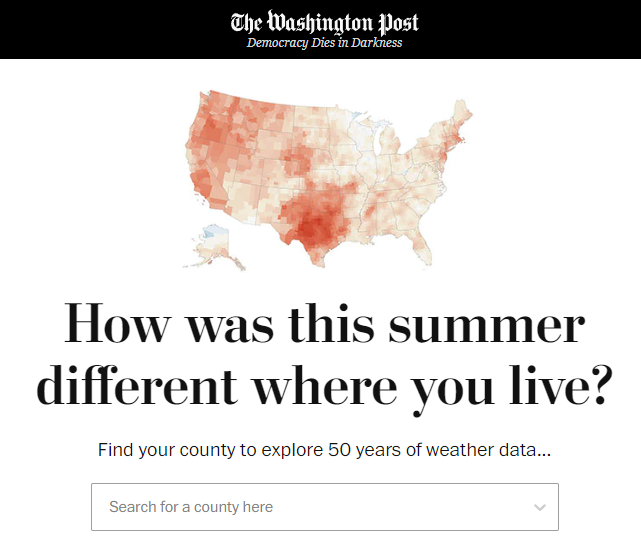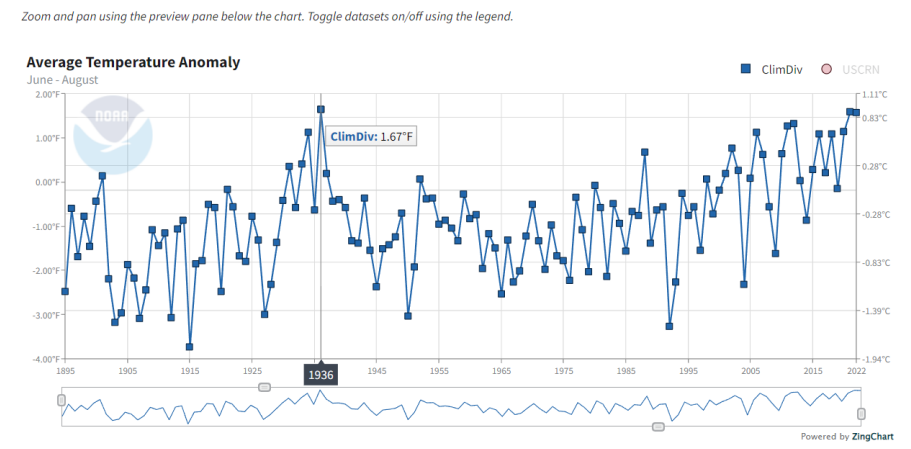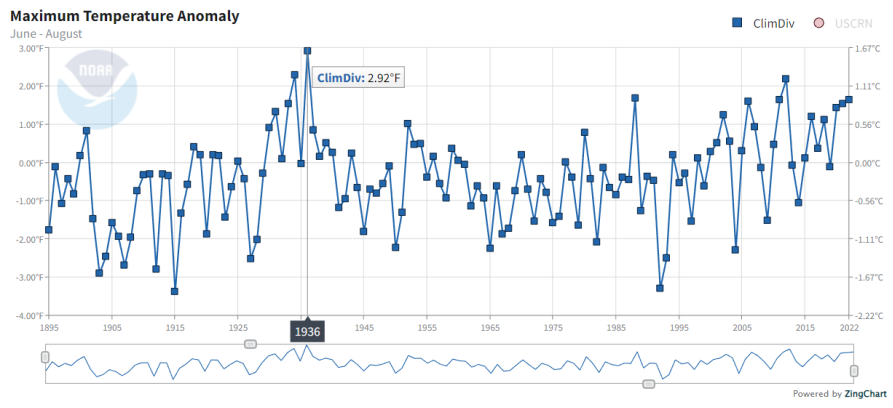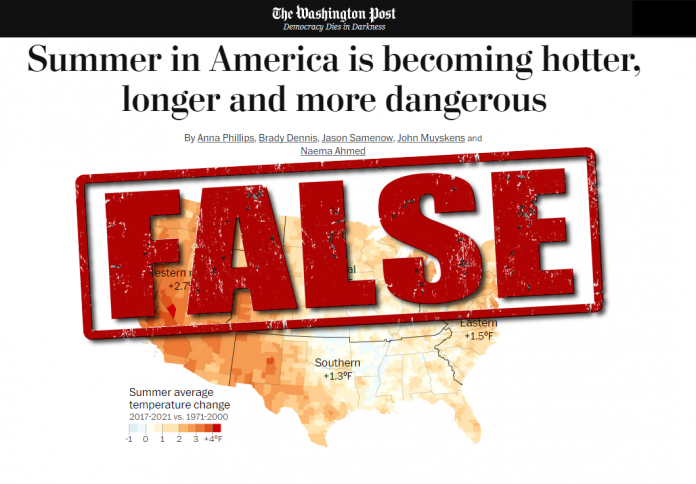A story in The Washington Post (WaPo), titled “Summer in America is becoming hotter, longer and more dangerous”, By Anna Phillips, Brady Dennis, Jason Samenow, John Muyskens, and Naema Ahmed, claims that compared to the last 50 years, summer heat is worse than ever. The story is absolutely false. In order to make the claim, the WaPo omits more than half of the U.S. temperature dataset they reference.
In scientific circles, such a tactic is called “cherry picking” where only the data desired to make your point is used. It is one of the most egregious violations of science because it is deliberate, rather than based in error or misinterpretation of data.
“Cherry picking is the deliberate practice of presenting the results of a study or experiment that best support the hypothesis or argument, instead of reporting all the findings.” says an online Psychology reference presented by Haverford University.
The United States surface temperature record extends back to 1895, yet WaPo decided to use only the most recent 50 years as a basis for their false claims about summer temperatures. As seen in the screen capture in Figure 1, they encourage readers to look at where they live.

The reason for the 50-year data limit is simple; had WaPo used the entire temperature dataset back to 1895, they would not be able to make the claim at all.
The lie isn’t even a skillful one, because you don’t even need to be a so-called journalist to discover this fact for yourself. The National Oceanic and Atmospheric Administration (NOAA) makes all this data publicly available, providing visualization tools for the data that anyone can use.
Meteorological summer is defined as the months of June, July, and August. NOAA’s online temperature plotting tool allows anyone to select for that data to visualize it. By selecting August, and then a three-month span, the months of June, July, and August are included all the way back to 1895.
The WaPo story chose average temperature data for the summer months. The full data set is plotted, as seen in Figure 2 below.

If you look at 1936, highlighted in Figure 2 above, you see that it is the highest point (1.67°F) in the entire summer average temperature dataset. The summers of 2021 and 2022, while the highest since then, don’t exceed 1936. Summer 2022 was at 1.60°F, and summer 2021 was at 1.63°F. You can download the actual data yourself here. Indeed, even 1934 was nearly as hot or hotter than most recent years such as 2016, 2018, and 2020.
Of course, if you only looked at 50 years of data back to 1972, you’d think that 2021 and 2022 were the hottest summers ever – and that’s the lie by omission WaPo made.
One more instance of cherry picking is evident from the entire data set. It is likely not a coincidence that WaPo chose the early 70s to begin as a reference point for the data set. That time period recorded among the lowest temperatures of the past 150 years. Many scientists and the mainstream media at the time were warning an impending ice age because of the pronounced cooling trend from the 1940s and recent geologic history indicating the next ice age may be overdue. One way to make temperatures appear hotter now than ever is to start your data set from a period of extremely low temperatures.
Another lie of omission is based on WaPo’s choice of words in their title, “Summer in America is becoming hotter…” which suggests higher temperatures in the present than the U.S. has ever experienced.
With one simple change of the NOAA online temperature plotting tool, we can switch from average summer temperature to maximum summer temperatures. The results in Figure 3 speak clearly to that point.

Once again, Figure 3 shows summer 1936 was the hottest in the U.S. at 2.92°F above the climate normal for maximum temperatures. 1934 was also hotter than the years WaPo cites using this metric. If you trusted WaPo and their 50-year cherry pick exercise, you would not know this. You can download the actual full maximum temperature dataset here.
Further, a September 9th statement from NOAA about summer 2022 supports the findings in the temperature data:
“For meteorological summer (June 1 through August 31), the average temperature for the contiguous U.S. was 73.9 degrees F, 2.5 degrees above average, ranking as the third-hottest summer in 128 years.”
Having a “third-hottest summer in 128 years” is hardly anywhere close to WaPo’s headline of “…hotter, longer and more dangerous.” The U.S. had been through worse summers before, and with less modern conveniences like we have today – such as widespread air conditioning.
WaPo willfully ignored inconvenient summer temperature data to promote climate alarm in a way consistent with their preexisting view that the world faces a climate crisis. This buttresses the larger point we’ve made repeatedly on Climate Realism: most of the mainstream media is fully onboard with a belief that the present-day temperatures we experience are far worse than what was experienced in the past.
Of course, if that were true, WaPo wouldn’t have to hide the inconvenient data in their reports. The Washington Post should be ashamed, because this kind of reporting is not journalism, it is advocacy disguised as journalism.

















